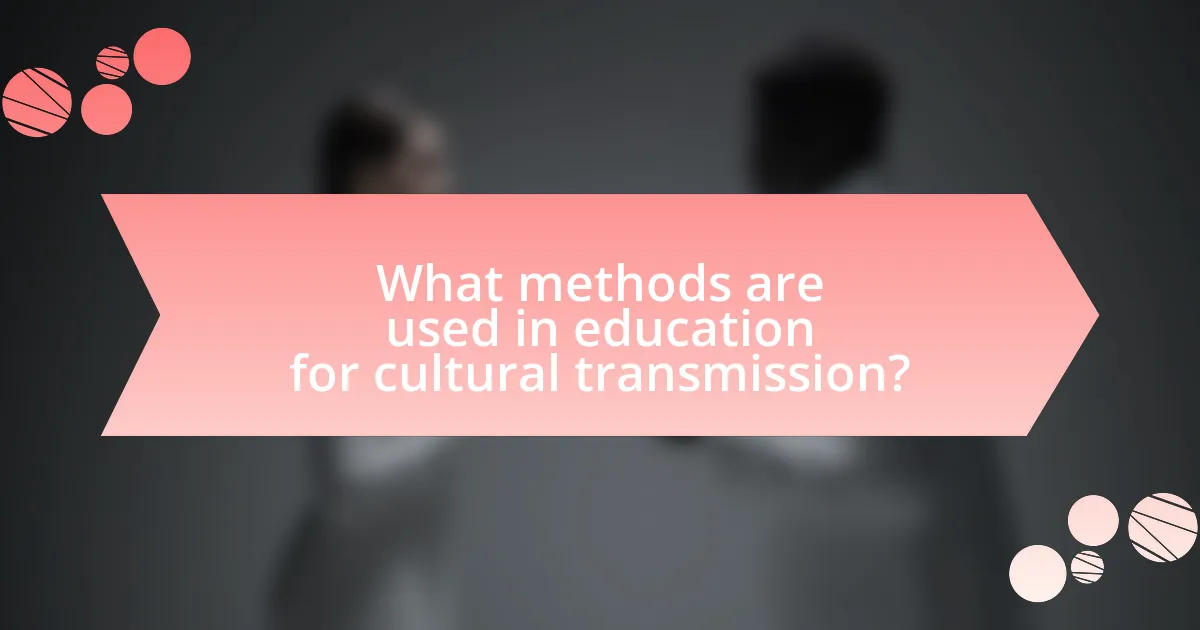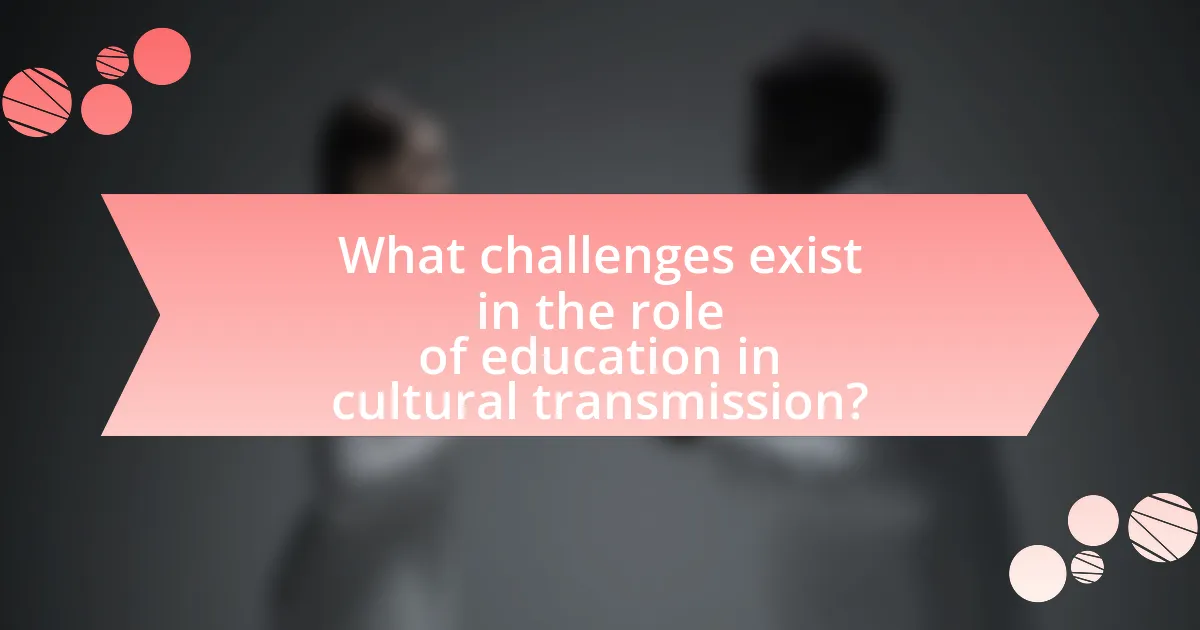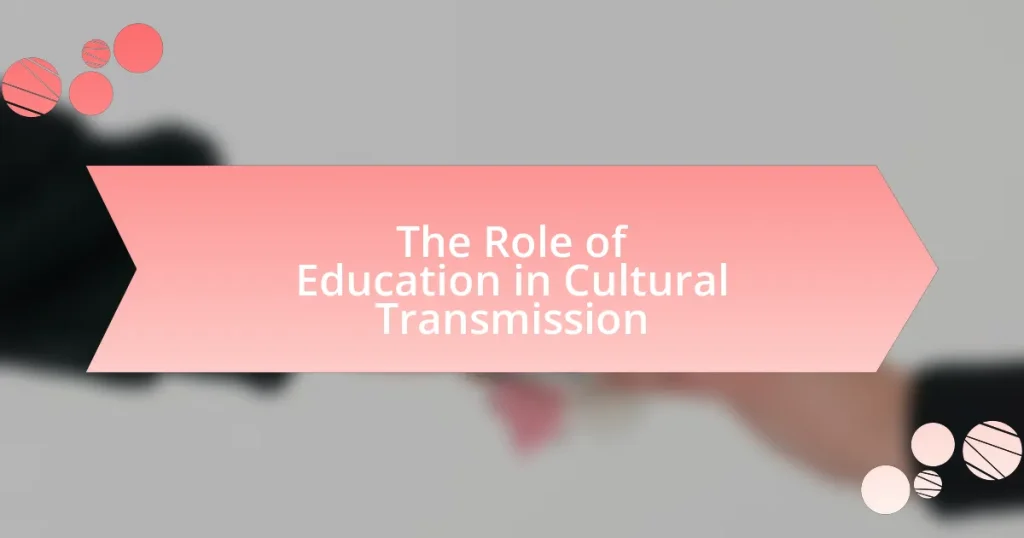The article examines the critical role of education in cultural transmission, emphasizing how educational institutions facilitate the transfer of knowledge, values, and practices across generations. It highlights the importance of structured curricula in imparting cultural norms and fostering social cohesion, as well as the key cultural values such as respect, responsibility, and community engagement that are taught through education. The article also addresses the challenges of cultural diversity, globalization, and the risks of cultural homogenization, while proposing best practices for enhancing cultural education through inclusive curricula and community partnerships. Overall, it underscores the significance of education in shaping individual identities and promoting societal cohesion.

What is the Role of Education in Cultural Transmission?
Education plays a crucial role in cultural transmission by facilitating the transfer of knowledge, values, and practices from one generation to another. Through structured curricula, educational institutions impart cultural norms and historical contexts that shape individual and collective identities. For instance, studies show that formal education systems often include lessons on local history, literature, and traditions, which reinforce cultural continuity. Additionally, education promotes social cohesion by teaching shared values and fostering a sense of belonging within a community, as evidenced by research indicating that students who engage in culturally relevant pedagogy demonstrate higher levels of cultural awareness and appreciation.
How does education facilitate the sharing of cultural values?
Education facilitates the sharing of cultural values by providing structured environments where individuals learn and engage with diverse cultural perspectives. Through curricula that include history, literature, and social studies, educational institutions expose students to various cultural narratives and practices, fostering understanding and appreciation. For instance, studies show that multicultural education programs enhance students’ awareness of different cultures, leading to increased empathy and social cohesion. This process is supported by research from the National Education Association, which highlights that inclusive educational practices promote respect for cultural diversity and strengthen community ties.
What are the key cultural values transmitted through education?
The key cultural values transmitted through education include respect, responsibility, community engagement, and critical thinking. Education serves as a primary vehicle for instilling these values, shaping individuals’ behaviors and attitudes towards society. For instance, respect is often emphasized through classroom interactions and discussions about diversity, fostering an appreciation for different perspectives. Responsibility is cultivated through assignments and group projects that require accountability and collaboration. Community engagement is promoted through service-learning initiatives, encouraging students to contribute positively to their communities. Critical thinking is developed through analytical discussions and problem-solving exercises, equipping students with the skills to navigate complex societal issues. These values are essential for fostering social cohesion and preparing individuals to participate actively in civic life.
How do educational institutions shape cultural identity?
Educational institutions shape cultural identity by providing a structured environment where cultural values, norms, and practices are transmitted and reinforced. Through curricula that include history, literature, and social studies, schools impart knowledge about cultural heritage and societal values, fostering a sense of belonging and identity among students. For instance, research by the National Center for Education Statistics indicates that students exposed to diverse cultural perspectives in educational settings develop greater cultural awareness and appreciation, which contributes to their identity formation. Additionally, extracurricular activities, such as cultural clubs and events, further enhance students’ connection to their cultural roots, promoting a collective identity within the school community.
Why is cultural transmission important in education?
Cultural transmission is important in education because it facilitates the transfer of knowledge, values, and practices from one generation to the next, ensuring the continuity of cultural identity. This process enables students to understand their heritage and societal norms, which is essential for social cohesion and individual identity formation. Research indicates that educational systems play a crucial role in this transmission by incorporating cultural content into curricula, thereby reinforcing cultural values and practices. For instance, studies show that students who engage with their cultural heritage in educational settings demonstrate higher levels of cultural and community engagement, which supports the argument that cultural transmission is vital for fostering a sense of belonging and purpose within society.
What impact does cultural transmission have on societal cohesion?
Cultural transmission significantly enhances societal cohesion by fostering shared values, beliefs, and practices among individuals. This process occurs through education, which serves as a primary vehicle for passing down cultural norms and social expectations. For instance, studies show that societies with strong educational systems that emphasize cultural heritage tend to exhibit higher levels of social trust and cooperation. Research by Putnam (2000) in “Bowling Alone” indicates that communities with robust social networks, often cultivated through shared educational experiences, demonstrate greater civic engagement and lower crime rates. Thus, cultural transmission through education not only strengthens individual identity but also unites diverse groups, leading to a more cohesive society.
How does cultural transmission influence individual identity formation?
Cultural transmission significantly influences individual identity formation by shaping beliefs, values, and behaviors through socialization processes. This occurs primarily within educational settings, where individuals learn cultural norms and practices from peers, teachers, and curricula. For instance, research by Bandura (1977) on social learning theory illustrates how individuals adopt behaviors and attitudes observed in their environment, reinforcing the idea that education serves as a critical medium for cultural transmission. Furthermore, studies indicate that cultural narratives taught in schools contribute to a sense of belonging and self-concept, as individuals align their identities with the cultural context they are exposed to. Thus, cultural transmission through education plays a vital role in the development of individual identity by embedding cultural frameworks within personal experiences.

What methods are used in education for cultural transmission?
Education employs various methods for cultural transmission, including formal instruction, storytelling, and experiential learning. Formal instruction involves structured curricula that teach cultural norms, values, and history, often through subjects like social studies and literature. Storytelling serves as a traditional method where oral narratives convey cultural heritage and moral lessons, fostering a sense of identity and continuity. Experiential learning, such as cultural immersion programs and community service, allows students to engage directly with cultural practices, enhancing understanding and appreciation. These methods collectively ensure that cultural knowledge is passed down through generations, reinforcing societal values and identity.
How do curricula reflect cultural values?
Curricula reflect cultural values by incorporating the beliefs, norms, and practices of a society into educational content and teaching methods. For instance, subjects such as history and literature often emphasize local traditions, historical events, and influential figures that shape a community’s identity. This alignment is evident in the inclusion of indigenous knowledge in curricula, which acknowledges and respects the cultural heritage of native populations. Research shows that education systems that integrate cultural values foster a sense of belonging and identity among students, as seen in studies conducted by the National Education Association, which highlight the positive impact of culturally relevant pedagogy on student engagement and achievement.
What role do textbooks play in cultural transmission?
Textbooks play a crucial role in cultural transmission by serving as primary educational resources that convey societal values, norms, and knowledge to students. They systematically present information about history, literature, and social studies, which helps shape students’ understanding of their cultural heritage and identity. For instance, textbooks often include narratives that reflect the dominant culture’s perspectives, thereby influencing how students perceive their own culture and others. Research indicates that the content of textbooks can reinforce cultural stereotypes or promote inclusivity, impacting students’ social attitudes and behaviors (Apple, M.W. “Ideology and Curriculum,” Routledge, 2004). This demonstrates that textbooks are not merely educational tools but also instruments of cultural continuity and change.
How can educators incorporate local culture into their teaching?
Educators can incorporate local culture into their teaching by integrating culturally relevant materials, examples, and practices into the curriculum. This approach allows students to connect their learning with their cultural backgrounds, enhancing engagement and understanding. For instance, using local history, folklore, and traditions in lessons can make subjects like history and literature more relatable. Research indicates that culturally responsive teaching improves student achievement and fosters a sense of belonging, as shown in studies by (2010) in “Culturally Responsive Teaching: Theory, Research, and Practice.” By actively involving local community members and resources, educators can create a richer learning environment that honors and reflects the diversity of the students’ cultural experiences.
What role do teachers play in cultural transmission?
Teachers play a crucial role in cultural transmission by imparting knowledge, values, and norms to students. They serve as facilitators of cultural understanding, guiding learners through the complexities of their society’s heritage and traditions. Research indicates that teachers influence students’ cultural identity and socialization processes, as they model behaviors and attitudes reflective of their culture. For example, studies have shown that educators who incorporate local history and cultural practices into their curriculum enhance students’ connection to their community, thereby reinforcing cultural continuity.
How can teachers model cultural values in the classroom?
Teachers can model cultural values in the classroom by integrating diverse cultural perspectives into the curriculum and promoting inclusive practices. By incorporating literature, history, and examples from various cultures, educators can demonstrate respect for different traditions and beliefs. Research indicates that when teachers actively engage students in discussions about cultural differences and similarities, it fosters an environment of understanding and acceptance. For instance, a study by (2010) in “Culturally Responsive Teaching” highlights that culturally relevant pedagogy enhances student engagement and academic success, reinforcing the importance of modeling cultural values effectively.
What strategies can teachers use to promote cultural awareness?
Teachers can promote cultural awareness by incorporating diverse curricula that reflect various cultures and perspectives. This approach allows students to engage with different cultural narratives, fostering empathy and understanding. For instance, studies show that multicultural education can enhance students’ cultural competence and reduce prejudice (Banks, 2016). Additionally, teachers can facilitate cultural exchange programs or virtual collaborations with classrooms in different countries, providing firsthand experiences of diverse cultures. Research indicates that experiential learning significantly improves cultural awareness among students (Dewey, 1938). Furthermore, inviting guest speakers from various cultural backgrounds can enrich classroom discussions and provide authentic insights into different cultural practices and values.

What challenges exist in the role of education in cultural transmission?
Education faces several challenges in cultural transmission, primarily including the diversity of cultural backgrounds among students, the potential for cultural homogenization, and the influence of technology. The diversity of cultural backgrounds can lead to conflicts in values and beliefs, making it difficult for educators to create a unified curriculum that respects and incorporates multiple perspectives. Cultural homogenization occurs when dominant cultures overshadow minority cultures, risking the loss of unique cultural identities. Additionally, the rise of technology can lead to the prioritization of digital content over traditional cultural teachings, which may dilute the transmission of cultural practices and values. These challenges highlight the complexities educators must navigate to effectively transmit culture within increasingly diverse and technologically influenced classrooms.
How do globalization and multiculturalism affect cultural transmission in education?
Globalization and multiculturalism significantly enhance cultural transmission in education by facilitating the exchange of diverse cultural perspectives and practices. This interaction allows students to engage with a variety of cultural narratives, promoting inclusivity and understanding. For instance, educational curricula increasingly incorporate global histories and multicultural viewpoints, which enrich students’ learning experiences and foster critical thinking. Research indicates that schools with multicultural programs report higher levels of student engagement and academic achievement, as they reflect the diverse backgrounds of their student populations. This evidence underscores the positive impact of globalization and multiculturalism on cultural transmission within educational settings.
What are the risks of cultural homogenization in education?
Cultural homogenization in education poses significant risks, including the erosion of cultural diversity and the loss of unique identities. When educational systems prioritize a singular cultural narrative, they diminish the representation of minority cultures, leading to a lack of understanding and appreciation for diverse perspectives. Research indicates that this can result in students feeling alienated and disconnected from their heritage, which negatively impacts their self-esteem and cultural . Furthermore, homogenization can stifle critical thinking and creativity, as students are less exposed to varied viewpoints and problem-solving approaches. Studies, such as those by the American Educational Research Association, highlight that diverse educational environments foster better academic outcomes and social cohesion, underscoring the importance of maintaining cultural diversity in educational settings.
How can educators address cultural biases in the curriculum?
Educators can address cultural biases in the curriculum by implementing inclusive teaching practices that reflect diverse perspectives and histories. This can be achieved through the integration of multicultural content, which ensures that various cultural narratives are represented in educational materials. Research indicates that curricula incorporating diverse viewpoints enhance student engagement and promote critical thinking, as evidenced by a study published in the “Journal of Educational Psychology,” which found that students exposed to multicultural education demonstrated improved academic performance and social awareness. Additionally, educators can engage in professional development focused on cultural competency, enabling them to recognize and mitigate their own biases, thereby fostering an equitable learning environment.
What are the implications of failing to transmit culture through education?
Failing to transmit culture through education leads to a loss of cultural identity and heritage. This absence can result in diminished social cohesion, as individuals may struggle to connect with their community and shared values. Research indicates that cultural transmission is essential for maintaining traditions and social norms, which are crucial for societal stability. For instance, studies show that communities with strong cultural education programs exhibit higher levels of trust and cooperation among members. Without these educational frameworks, younger generations may become disconnected from their roots, leading to cultural homogenization and a decline in diversity.
How does a lack of cultural transmission affect future generations?
A lack of cultural transmission negatively impacts future generations by hindering their understanding of identity, values, and social norms. Without the passing down of cultural knowledge, children may struggle to form a cohesive sense of self and community, leading to disconnection and confusion about their place in society. Research indicates that cultural transmission is essential for social cohesion and individual identity formation; for instance, studies show that children who are not exposed to their cultural heritage often experience lower self-esteem and a diminished sense of belonging. This gap in cultural knowledge can result in a loss of traditions, languages, and practices, ultimately weakening the social fabric and continuity of communities over time.
What are the consequences for social cohesion and identity?
The consequences for social cohesion and identity are significant, as education plays a crucial role in shaping collective values and social bonds. Education fosters a shared understanding of cultural norms and promotes inclusivity, which strengthens social cohesion. For instance, studies show that inclusive educational practices can reduce social divisions and enhance community engagement, leading to a more unified society. Furthermore, education contributes to individual identity formation by providing knowledge and skills that align with cultural heritage, thereby reinforcing a sense of belonging. Research indicates that societies with strong educational frameworks tend to exhibit higher levels of social trust and cooperation, which are essential for maintaining social cohesion.
What best practices can enhance the role of education in cultural transmission?
Integrating experiential learning into education enhances cultural transmission by allowing students to engage directly with cultural practices. This approach fosters deeper understanding and appreciation of diverse cultures through hands-on experiences, such as cultural festivals, community service, and field trips. Research indicates that experiential learning increases retention rates and cultural empathy, as evidenced by a study published in the Journal of Educational Psychology, which found that students participating in experiential learning activities demonstrated a 30% higher retention of cultural knowledge compared to traditional learning methods. Additionally, incorporating multicultural curricula that reflect diverse perspectives and histories promotes inclusivity and respect for different cultures, further solidifying the role of education in cultural transmission.
How can schools create inclusive environments for cultural exchange?
Schools can create inclusive environments for cultural exchange by implementing multicultural curricula that reflect diverse perspectives and histories. This approach fosters understanding and respect among students from various backgrounds, promoting dialogue and collaboration. Research indicates that schools with inclusive curricula see improved student engagement and academic performance, as evidenced by a study published in the Journal of Educational Psychology, which found that students exposed to diverse cultural content demonstrated higher levels of empathy and social awareness. Additionally, schools can facilitate cultural exchange through events such as international days, where students share their traditions, and by encouraging partnerships with local cultural organizations, enhancing community ties and enriching the educational experience.
What community partnerships can support cultural education initiatives?
Community partnerships that can support cultural education initiatives include collaborations with local cultural organizations, schools, libraries, and museums. These partnerships enhance educational programs by providing resources, expertise, and access to cultural artifacts. For instance, partnerships with museums can facilitate workshops and exhibitions that promote cultural awareness, while collaborations with local cultural organizations can offer authentic experiences through performances and festivals. Research indicates that such partnerships significantly improve student engagement and understanding of diverse cultures, as evidenced by programs like the Smithsonian Institution’s educational outreach, which has successfully integrated cultural education into school curricula across the United States.
